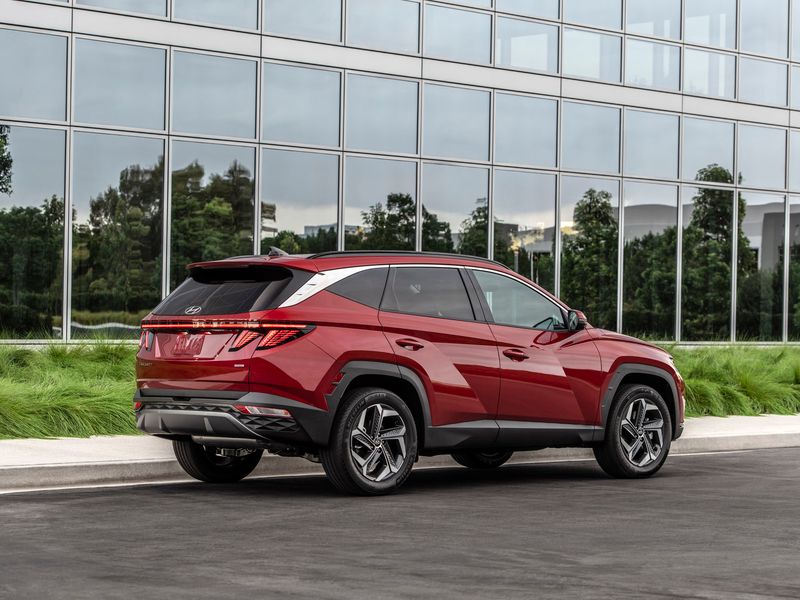
If creases and origami are your thing, the fourth-generation Tucson crossover will have appeal.
Redesigned for 2022, Hyundai’s compact crossover offers more comfort, polish, power, room and safety gear than what Consumer Reports called the mediocre model it replaces.
Car and Driver calls the exterior styling “daring” and destined to shake up the compact-SUV segment.
Under the hood, the latest Tucson is equipped with a 2.5-liter, direct-injection, four-cylinder gasoline engine or a 1.6-liter, turbocharged, direct-injection hybrid or plug-in hybrid setup. The base 2.5-liter engine cranks out 187 hp, while the hybrid powertrain generates 227 hp.
It competes in one of the toughest industry segments that is dominated by the Toyota RAV4, Honda CR-V, Nissan Rogue, Chevrolet Equinox, Mazda CX-5 and Ford Escape.
We’ve collected some early reviews of the 2022 Tucson.
“This engine is perfectly fine around town and on the highway, but it certainly doesn’t make the Tucson quick or sporty-feeling. The transmission can be sluggish to downshift, but at least the Limited comes with paddle shifters.
“The Tucson’s steering is both lightly weighted and light on feedback, and there’s a good amount of body roll in the corners. But what this crossover lacks in sportiness it makes up for in comfort. Even on the Limited’s 19-inch wheels the Tucson soaks up bumps and rough surfaces, delivering a superb ride that’s smoother than any of its competitors — even the refined Mazda CX-5. It’s luxury-car quiet on the inside, too, though the noisy engine sometimes cuts through that serenity under hard acceleration.”
— Daniel Golson, Roadshow by CNET
“One thing confused us: The push-button transmission has no ‘B’ mode to crank up the regenerative braking, which recharges the battery as the vehicle decelerates. Using the steering-wheel-mounted paddles downshifts the transmission but doesn’t turn up the regen. The only way to take advantage of regenerative braking on a long downgrade is to ride the brake pedal — but Hyundai’s integration of regenerative and friction braking is so seamless (something some automakers can’t seem to get right) it’s impossible to tell if you’re merely charging the battery or if you’re well on your way to boiling your brake fluid. Considering how much thought Hyundai put into the smart regenerative brake controls on the battery-powered Kona Electric, it’s curious that this important feature has been all but ignored in the Tucson Hybrid.”
— Aaron Gold, Motor Trend
“As impressive as the exterior is, the interior is better. There are some echoes of Honda in there, some touches of Lexus and a big chunk of Audi, but it all works together. Just to show that Hyundai hasn’t abandoned the funk altogether, the steering wheel has a goofy design with four spokes in the lower third of the wheel. But it is well sized, and its rim has a nice squish to it.
“The stars here are the twin 10.3-inch screens. The one in front of the driver is brilliant enough that it doesn’t require a hood over it to provide shade, and the center screen has a more or less intuitive interface. (And in the context of current infotainment systems, ‘more or less’ is a synonym for ‘pretty good.’) What’s missing? How about a volume knob for the sound system? Come on, it’s easy. Hyundai also claims the new Tucson has some neat interior ambient lighting, but the press preview drive was conducted in daylight, so that remains to be seen.”
— John Pearley Huffman, Car and Driver
“It’s because of all the design and interior goodness that the disappointment rings so loudly with the normally aspirated 2.5-liter engine’s behavior. Forget for a moment that the hybrid’s balance sheet shows 226 total horsepower (261 total horsepower for the plug-in hybrid version) and 258 pound-feet of total torque versus the 2.5-liter gas engine’s 187 hp and 178 lb-ft of torque. Also ignore that the hybrid sips fuel at roughly a 30 percent lower rate than the standard engine (a Hyundai-estimated 38 mpg combined versus 26 mpg combined with AWD).
“Even if the two powertrains belted out precisely the same power and efficiency figures, the hybrid would still win this contest every time because the 2.5-liter engine is four cylinders of vibey, thrashy discontent compared to the muted, smooth and hushed pairing of 1.6-liter turbo and electric motor. And that’s not just true at the top end of the 2.5-liter engine’s breathing capacity at around 6,000 rpm. The 2.5’s responsiveness to throttle inputs at low engine speed is paused at best, laggardly at worst. The grand powertrain takeaway after piloting both the 2.5-liter and the hybrid Tucson proves the latter to be a much better driving mate in every possible condition.”
— Jim Resnick, Autoblog
“The redesigned Tucson grows in size and gains significant infotainment and connected technology, such as smartphone integration and remote parking capability — features associated with more expensive models. Plus, it throws in some design flair.
“Hyundai needed to make up some ground to be competitive, and based on our initial time with three Tucsons, the redesigned SUV is a serious contender. It benefits from the more accomplished ride, handling, quietness, and high-tech conveniences seen in the three-row Palisade and in the recently freshened Santa Fe.
“Among the three versions, the hybrid in particular shines. It brings both extra power and much better fuel economy. It accelerates smoothly without traditional compromises associated with hybrids.”
— Jeff Bartlett, Consumer Reports